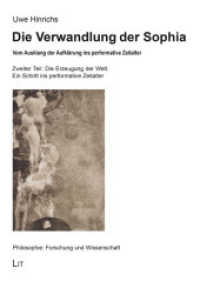- ホーム
- > 洋書
- > 英文書
- > Nature / Ecology
基本説明
Originally published as an issue of philosophical Transactions of the Royal Society.
Full Description
What determines where a species lives? And what determines its abundance? This book takes a fresh approach to some of the classic questions in ecology. Despite great progress in the twentieth century much more remains to be done before we can provide full answers to these questions. The methods described and deployed in this book point the way forward. The core message of the book is that the key insights come from understanding what determines population growth rate, and that application of this approach will make ecology a more predictive science. Topics covered include population regulation, density-dependence, the ecological niche, resource and interference competition, habitat fragmentation and the ecological effects of environmental stress, together with applications to conservation biology, wildlife management, human demography and ecotoxicology. After a substantial introduction by the editors the book brings together contributions from leading scientists from Australia, New Zealand, North America, Europe and the U.K.
Contents
Introduction R. M. Sibly, J. Hone and T. H. Clutton-Brock; 1. Population growth rate and its determinants: an overview R. M. Sibly and J. Hone; 2. Demographic, mechanistic and density-dependent determinants of population growth rate: a case study in an avian predator J. Hone and R. Sibly; 3. Estimating density dependence in time series of age-structured populations R. Lande, S. Engen and B.-E. Sæther; 4. Pattern of variation in avian population growth B.-E. Sæther and S. Engen; 5. Determinants of human population growth W. Lutz and R. Quaing; 6. Two complementary paradigms for analyzing population dynamics C. J. Krebs; 7. Complex numerical responses to top-down and bottom-up processes in vertebrate populations A. R. E. Sinclair and C. J. Krebs; 8. The numerical response: rate of increase and food limitation in herbivores and predators P. Bayliss and D. Choquenot; 9. Populations in variable environments: the effect of variability in a species' primary resource S. A. Davis, R. P. Pech and E. A. Catchpole; 10. Trophic interactions and population growth rates: describing patterns and identifying mechanisms P. J. Hudson, A. P. Dobson, I. M. Cattadori, D. Newborn, D. T. Haydon, D. J. Shaw, T. Benton and B. Grenfell; 11. Behavioural models of population growth rates: implications for conservation and prediction W. J. Sutherland and K. Norris; 12. Comparative ungulate dynamics: the devil is in the detail T. H. Cluttton-Brock and T. Coulson; 13. Population growth rate as a basis for ecological risk assessment of toxic chemicals V. Forbes and P. Calow;14. Population growth rates: issues and an application H. C. J. Godfray and M. Rees; Index.






